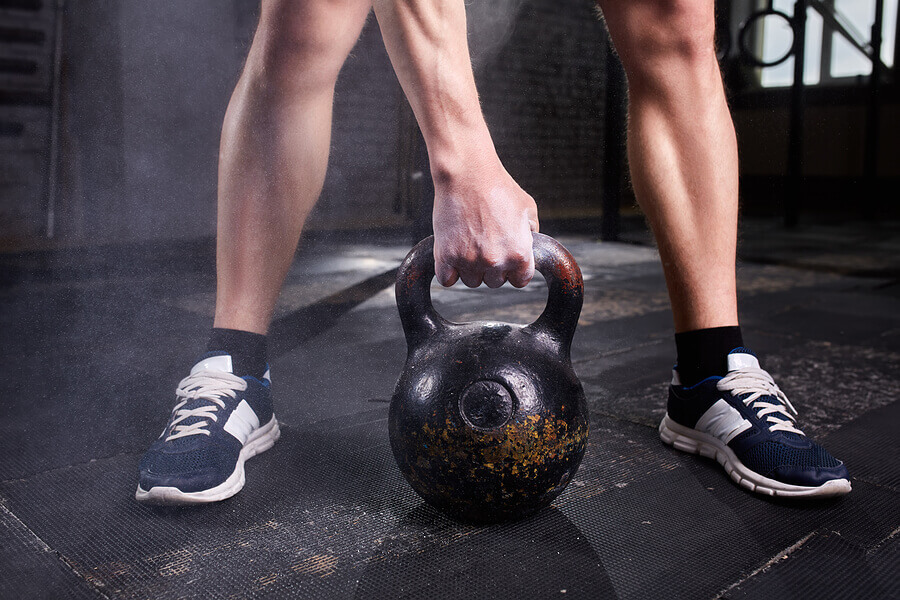Strength Training Mechanisms

Along with speed, endurance, and flexibility, strength is another basic physical trait. Strength is the body’s capacity of withstanding or overcoming an external force by tensing up its muscles. Rather than what you’re born with, your strength almost entirely depends on how you train your musculoskeletal system. In today’s post, learn about the mechanisms for strength training.
Strength training mechanisms: physiology
If strength is the body’s capacity of withstanding an external force by generating tension in its muscles, we have to first understand how the body produces said tension.
Muscle tissue encompasses three main types:
- Smooth muscle tissue: present in organs and blood vessels. These tissues work involuntarily.
- Cardiac muscle tissue: present in the heart. They also work involuntarily and are responsible for keeping the heart pumping consistently.
- Skeletal muscle tissue: present in the muscles and allows movement. Skeletal muscle tissue works voluntarily. The brain sends a message to these tissues through the motor neurons in the spinal cord.
Muscles are made up of two filamentous molecules called actin and myosin. When a muscle is relaxed, the molecules separate from each other. But, when the brain sends a signal to move, the molecules work with calcium to come together and create tension in the entire motor unit.
The tension that the molecules created in the motor unit is muscle contraction. The resulting strength depends on how many contractions they can generate.

Strength training mechanisms
Now that we understand how muscles contract and what they are, we can move onto the essential strength training mechanisms. Knowing these mechanisms is especially important for those who practice sports that require higher levels of strength.
Muscular hypertrophy
The best-known strength training mechanism is hypertrophy. Muscular hypertrophy results from enlarging muscle fiber. When muscle fibers grow, they are able to generate more tension in contraction. Hypertrophy is the main objective for people who work on getting stronger, especially those who hit the gym regularly or participate in programs such as CrossFit.
However, despite being the best-known mechanism, it isn’t the most important one. This is especially true if you’re just starting a strength training sport and are starting to grow. Hypertrophy is actually more helpful for people well into advanced workouts.
Muscle coordination: strength training mechanisms:
Improving muscle coordination is another essential factor for strength training. Muscle coordination improves by internalizing movement patterns on a neuromuscular level. For example, if you repeat squats with weights over and over again, your muscles learn when to activate and when to relax. They also learn when they need to work as stabilizers.
Continuing with the same example, in the concentric phase– or when you go up– your quads and glutes contract while your hamstrings relax. Meanwhile, your back and abdomen muscles act as stabilizers.
This mechanism even takes place in beginners who haven’t mastered their technique or movements yet. As you continue steadily with your workouts, the strides of progress shrink and different mechanisms become the primary source of improvement.

Motor unit recruitment
Another fundamental mechanism is recruiting the muscle fibers that participate in a certain movement. Just as we mentioned earlier in our post, as you steadily continue your workouts, your muscle coordination improves and knows when to activate certain muscles or when not to. But in addition to muscle coordination, steady workouts also improve your body’s ability to recruit muscle fibers.
Through repetitive movements, the body uses new nerve endings to activate muscle fibers that it hasn’t used before. When more muscle fibers join the action, they produce more strength.
Motor unit recruitment is the most effective mechanism for people who are just starting out or have reached an intermediate level. If you’re advanced in your muscle training, almost all of your muscle fibers will already be in sync and further strength training has to depend on hypertrophy.
Wrapping up, these are the three main ways to grow stronger. Each mechanism can offer more or fewer benefits depending on where you are in your workouts. But, they all contribute to the same goal: building strength to later apply it to physical tasks.
Along with speed, endurance, and flexibility, strength is another basic physical trait. Strength is the body’s capacity of withstanding or overcoming an external force by tensing up its muscles. Rather than what you’re born with, your strength almost entirely depends on how you train your musculoskeletal system. In today’s post, learn about the mechanisms for strength training.
Strength training mechanisms: physiology
If strength is the body’s capacity of withstanding an external force by generating tension in its muscles, we have to first understand how the body produces said tension.
Muscle tissue encompasses three main types:
- Smooth muscle tissue: present in organs and blood vessels. These tissues work involuntarily.
- Cardiac muscle tissue: present in the heart. They also work involuntarily and are responsible for keeping the heart pumping consistently.
- Skeletal muscle tissue: present in the muscles and allows movement. Skeletal muscle tissue works voluntarily. The brain sends a message to these tissues through the motor neurons in the spinal cord.
Muscles are made up of two filamentous molecules called actin and myosin. When a muscle is relaxed, the molecules separate from each other. But, when the brain sends a signal to move, the molecules work with calcium to come together and create tension in the entire motor unit.
The tension that the molecules created in the motor unit is muscle contraction. The resulting strength depends on how many contractions they can generate.

Strength training mechanisms
Now that we understand how muscles contract and what they are, we can move onto the essential strength training mechanisms. Knowing these mechanisms is especially important for those who practice sports that require higher levels of strength.
Muscular hypertrophy
The best-known strength training mechanism is hypertrophy. Muscular hypertrophy results from enlarging muscle fiber. When muscle fibers grow, they are able to generate more tension in contraction. Hypertrophy is the main objective for people who work on getting stronger, especially those who hit the gym regularly or participate in programs such as CrossFit.
However, despite being the best-known mechanism, it isn’t the most important one. This is especially true if you’re just starting a strength training sport and are starting to grow. Hypertrophy is actually more helpful for people well into advanced workouts.
Muscle coordination: strength training mechanisms:
Improving muscle coordination is another essential factor for strength training. Muscle coordination improves by internalizing movement patterns on a neuromuscular level. For example, if you repeat squats with weights over and over again, your muscles learn when to activate and when to relax. They also learn when they need to work as stabilizers.
Continuing with the same example, in the concentric phase– or when you go up– your quads and glutes contract while your hamstrings relax. Meanwhile, your back and abdomen muscles act as stabilizers.
This mechanism even takes place in beginners who haven’t mastered their technique or movements yet. As you continue steadily with your workouts, the strides of progress shrink and different mechanisms become the primary source of improvement.

Motor unit recruitment
Another fundamental mechanism is recruiting the muscle fibers that participate in a certain movement. Just as we mentioned earlier in our post, as you steadily continue your workouts, your muscle coordination improves and knows when to activate certain muscles or when not to. But in addition to muscle coordination, steady workouts also improve your body’s ability to recruit muscle fibers.
Through repetitive movements, the body uses new nerve endings to activate muscle fibers that it hasn’t used before. When more muscle fibers join the action, they produce more strength.
Motor unit recruitment is the most effective mechanism for people who are just starting out or have reached an intermediate level. If you’re advanced in your muscle training, almost all of your muscle fibers will already be in sync and further strength training has to depend on hypertrophy.
Wrapping up, these are the three main ways to grow stronger. Each mechanism can offer more or fewer benefits depending on where you are in your workouts. But, they all contribute to the same goal: building strength to later apply it to physical tasks.
All cited sources were thoroughly reviewed by our team to ensure their quality, reliability, currency, and validity. The bibliography of this article was considered reliable and of academic or scientific accuracy.
- Folland JP, Williams AG. The Adaptations to Strength Training. Sport Med [Internet]. 2007 [cited 2019 Jul 28];37(2):145–68. Available from: http://www.ncbi.nlm.nih.gov/pubmed/17241104
- Moritani T, deVries HA. Neural factors versus hypertrophy in the time course of muscle strength gain. Am J Phys Med [Internet]. 1979 Jun [cited 2019 Jul 28];58(3):115–30. Available from: http://www.ncbi.nlm.nih.gov/pubmed/453338
- Jenkins NDM, Miramonti AA, Hill EC, Smith CM, Cochrane-Snyman KC, Housh TJ, et al. Greater Neural Adaptations following High- vs. Low-Load Resistance Training. Front Physiol [Internet]. 2017 [cited 2019 Jul 28];8:331. Available from: http://www.ncbi.nlm.nih.gov/pubmed/28611677
This text is provided for informational purposes only and does not replace consultation with a professional. If in doubt, consult your specialist.








